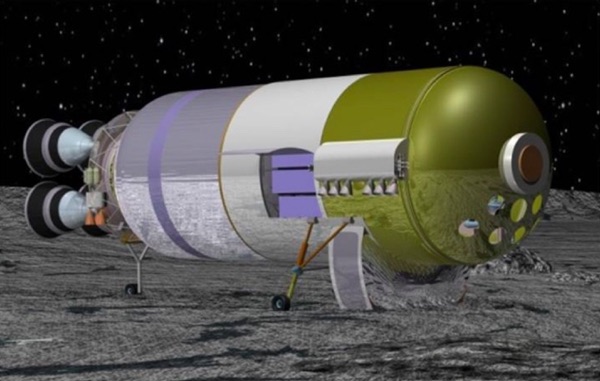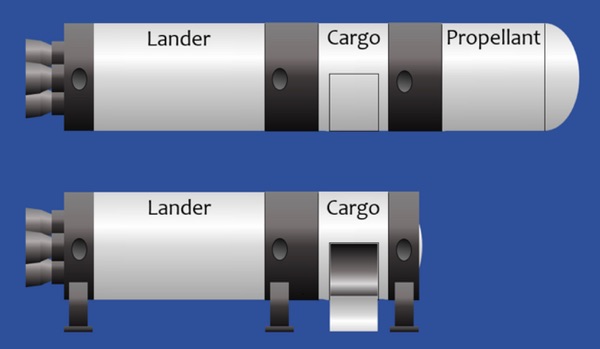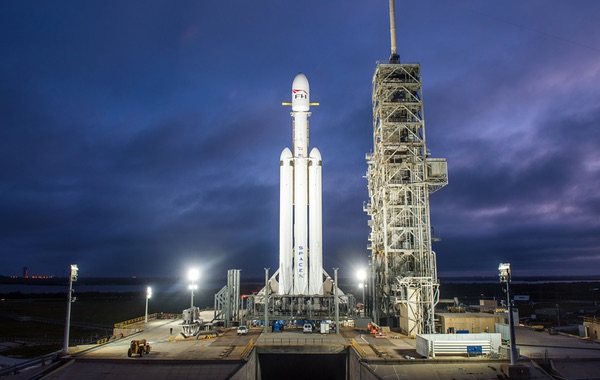Why the Falcon Heavy should be America's next Moon rocketby Doug Plata
|
| An initial cislunar transportation system would use the Falcon Heavy for the launch and a United Launch Alliance Xeus lander, using liquid hydrogen and liquid oxygen (hydrolox) propellants, for translunar injection and landing on the Moon. |
Obama committed to a policy that neglected returning crew to the surface of the Moon. Eight years later, that policy was reversed. I hope that the current administration will make the right policy choices so that we don’t lose more time. I am concerned that what appears to be the default policy (SLS, Orion, Deep Space Gateway, and someone’s lunar lander) will not be the most cost-effective way to return to the Moon and so progress will be slowed. Once again, expensive programs will be vulnerable to yet another cancellation.
Different launchers and landers could be utilized as part of a cost-effective public-private return-to-the-Moon (RTM) program (PPPs). But, because they are potentially the nearest available hardware, I describe here an initial cislunar transportation system utilizing the Falcon Heavy for the launch and a United Launch Alliance Xeus lander, using liquid hydrogen and liquid oxygen (hydrolox) propellants, for translunar injection and landing on the Moon. Vulcan, New Glenn, Blue Moon, and the Big “Falcon” Rocket (BFR) could and should compete for contracts within a “Lunar COTS” public private partnership (PPP). But, especially in the case of the BFR, we cannot expect the decision makers in DC to select hardware that, at this point, is far from demonstrated reality. To get going with lunar development we need to start with near-term hardware and then transition to better hardware as that comes along.
Would companies such as SpaceX, ULA, and others work together in a set of PPPs? Elon Musk has stated that he has nothing against the Moon and would be happy to sell launches to whoever wanted to go there. In a conversation with a ULA executive, I was told that they would jump at the opportunity to have the development of their Xeus lander largely paid for. So, if NASA were to put up the money, it seems to me likely that the companies would gladly bid for those contracts and play nice together.
The Falcon Heavy would be able to put an estimated 63.8 metric tons of payload to LEO in its fully expendable form. Its current kerosene and liquid oxygen, or keralox, engines are not the best suited for sending payload beyond LEO. But a hydrolox lander with an external propellant drop tank could utilize the lander’s engines to depart from LEO all the way to landing on the lunar surface. So, together, these hardware elements could send as much as ten metric tons of payload to the lunar surface one way. The initial launches could send cargo such as solar power systems, telerobotic hardware, equipment, habitats, and supplies prior to launching a lander with a crew module. In this way, lander experience could be gained prior to sending crew on the lander.
Savvy space advocates will recognize certain issues, such as SpaceX’s lack of hydrolox capability at its launch sites, the extended length of the lander stack, and limited ability to send return propellant for an eventual crewed mission with a single Falcon Heavy launch. Again, we need to have a thorough examination of possible architectures to address the challenges. But if a Falcon Heavy launch with an extended stack with a hydrolox (upper stage) lander is not possible, then a couple of launches per lunar missions would still be more cost-effective than an SLS-based architecture.
Speaking of which, this article is proposing that the SLS not be used for accessing the Moon but instead that such a super heavy-lift vehicle (SHLV) be reserved for where that level of capability is actually needed: for crewed missions to Mars. Rather than trying to fit two destinations into a single transportation architecture, shouldn’t we at least first consider what is the most cost-effective and near-term transportation system for each destination? Indeed, if we want lunar development to be sustainable, would a transportation architecture relying on an SLS launcher costing, say, $1.5 billion per launch be the best choice to eventually transition to a sustainable commercial transportation system? Why not do as we’ve done with the COTS program and start with those vehicles that will become the final commercial transportation system?
| Rather than trying to fit two destinations into a single transportation architecture, shouldn’t we at least first consider what is the most cost-effective and near-term transportation system for each destination? |
Some may point out that SpaceX plans to transition away from the Falcon family of rockets towards the BFR. Good for them. But Musk has made it very clear that they will continue the Falcon family of rockets for as long as their customers demand them. Perhaps the policy should be to do a block buy of a certain number of Falcon Heavy launches (say, 10 to 20) so as to lock in that capability and at SpaceX’s “everyday low prices.” It would mean that we’re serious about returning to the Moon in a sustainable way and, frankly, SpaceX could really use more Falcon Heavy sales. If the BFR becomes a reliable reality, we would gladly transition from the Falcon Heavy to the BFR at that time.
The ULA/Masten Space Systems Xeus lander concept is less well-known that the Falcon Heavy launcher. The Xeus concepts have evolved over time, starting with the modification of the Centaur upper stage with its RL10 engine to become a lander designed to land belly down. A later version envisions it being a modification of ULA’s proposed Advanced Cryogenic Evolved Stage (ACES) upper stage. The ACES stage offers some remarkable innovations which could revolutionize cis-lunar transportation including potentially water-derived propellant, propellant transfer, and in-space propellant storage.
 An illustration of the ACES-based Xeus lander. (credit: ULA/Masten) |
Transportation architectures
The initial hardware sent to the Moon should be a few “telerobots” in an initial attempt to telerobotically harvest and process lunar polar ice into propellant. If successful, either telerobotically or after crew arrival, lunar-derived propellant would mean that each Falcon Heavy launch could result in about 20 metric tons of payload to be retrieved by a lander fully refueled on the Moon with a rendezvous and hand-off in cislunar space. At that point, the Falcon Heavy could deliver about as much payload to the lunar surface as the Saturn V.
It is beyond the scope of this article to go into detail about what could be accomplished by sending crew to the lunar surface. But let’s at least understand that, the next time we return to the Moon, it’s to stay. And this makes a huge difference. People beginning to move off Earth will be at the historically significant level of Christopher Columbus. Do we really want to leave this historic accomplishment to some other country? Please explore SpaceDevelopment.org to get a better understanding of how remarkable crew return to the Moon could be if done right.
Direct access to the Moon doesn’t require a Deep Space Gateway
The Apollo program didn’t require a Gateway, nor was it deemed necessary during the Constellation Program. It was only in the aftermath of the continually changing no-lunar-surface architecture of the Obama Administration that the Deep Space Gateway emerged. So, if the Space Policy Directive 1 mandates that we go to the Moon first, then do we really need a Deep Space Gateway to reach the lunar surface? Is it the most cost-effective and fastest way of establishing a sustainable transportation system to the lunar surface? This proposed Falcon Heavy-Xeus transportation architecture argues that only a cislunar rendezvous point is needed for the vehicle coming from Earth and a refueled lunar lander/ferry to hand off cargo or crew modules. In a relay race, is a middle man really necessary to collect batons from the first runner only to hand them to a second runner? Why can’t one runner hand the baton (payload) directly to the second runner? Is it really that difficult to coordinate such a thing?
However, cislunar activities may be necessary prior to crewed missions to Mars. But the focus of those activities should be on what is actually essential to go to Mars and not try to force that architecture onto a lunar transportation system thereby making it much less cost effective.
 A notional representation of the lunar lander stack. The width of the stack is essentially the same for the Falcon Heavy as well as the ULA/Masten ACES Xeus lander. |
Lunar COTS
The large public-private programs (i.e. COTS, Commercial Cargo, and Commercial Crew) have and are proving themselves to be some of NASA’s most successful programs. Why not simply repeat that success to develop a transportation system beyond LEO to the lunar surface (aka “Lunar COTS”)? Whereas the PPPs funded the development of two launchers and two-and-a-half crew vehicles (not to mention COTS being indirectly responsible for the Falcon Heavy and partial reusability), the lander could be just the modification of an existing lander whose main engines are already developed, like the RL10.
| It is naive to think that the Trump Administration and other countries are going to be satisfied with going “to the Moon” by only going to lunar orbit. When we reach the surface of the Moon, we aren’t going to set up a base only to abandon it to go to Mars. |
The current, large PPPs have consistently grown in budgetary support to where they are funded at five percent of NASA’s budget. With the addition of habitat and surface hardware, it is suggested that a Lunar COTS program ought not to cost more than about five to seven percent of NASA’s budget, or just a bit over $1 billion per year. A leading Lunar COTS advocate in NASA informed me that there are a couple of funding wedges that could be identified within the current budget that could be applied to Lunar COTS. One of them is an overestimate of how much the Commercial Crew program would cost. The point here is that it need not take a large increase in NASA’s budget, or a death match with entrenched interests, to add a very modest Lunar COTS program into the budget especially given that crewed lunar return is now official White House policy.
I would appeal to Mars advocates to support a Lunar COTS approach to crewed lunar return. It is naive to think that the Trump Administration and other countries are going to be satisfied with going “to the Moon” by only going to lunar orbit. When we reach the surface of the Moon, we aren’t going to set up a base only to abandon it to go to Mars. Likewise, companies aren’t going to develop the desired lunar access transportation system on their own dime. So, the more cost-effective lunar development is, the more budgetary space remains for Mars exploration. The Moon is a legitimate destination in its own right and not just a stepping stone to Mars. If we want to get to Mars in a timely and sustained manner, some thought needs to be given to find innovative ways to reduce the cost of a Mars exploration architecture rather than just stick with the unrealistic belief that NASA will dedicate all HSF funds towards Mars plus increase due to inflation (see “The Second Mars Affordability and Sustainability Community Workshop: structure, findings, and recommendations”, The Space Review, February 23, 2015).
Lunar COTS needs to be on the scale of the current public private programs (that is, about five percent of NASA’s budget). Small commercial launches in support of the “real” program (i.e. SLS-Orion-DSG) is not the model that has proven so successful. To be sustainable, we need to use PPPs to help private companies eventually establish a commercial transportation to the Moon for both cargo and crew.
Policy and advocacy considerations
An approach to lunar return using a cost-effective transportation system would offer the current administration some real policy benefits, and it is to them that this article is primarily directed. It is always difficult for an administration to change policy direction once they officially announced it. So, if they are being advised towards the default path to the Moon (again, SLS, Orion, DSG), perhaps they should request an analysis of another approach (Lunar COTS, Falcon Heavy, Xeus) that might be more cost-effective and hence sustainable across administrations. It does them no good to have their program cancelled by a succeeding administration because the current plan is “unaffordable.” (Where have we heard that before?)
| Countries well beyond the current ISS partners could afford at least one seat in a lunar exploration mission. |
Also, a set of programs going beyond lunar exploration to lunar development means that this administration could solidify its legacy as the one that clearly initiated the process of humans beginning to move off Earth. Indeed, the transportation hardware for sending a large inflatable habitat to the lunar surface could be up and running before the end of a second term. At that rate, the selection of the first, long-term, commercial crew could begin right away.
Landers refueled from lunar resources could conduct suborbital exploration. All told, countries well beyond the current ISS partners could afford at least one seat in a lunar exploration mission. The current administration would be funding programs whereby American companies would provide very cost-effective transport to national astronauts who would explore the Moon on behalf of their own citizens and in their own language. The goodwill thereby generated could be rather helpful, all things considered. A more direct and hence faster path to the Moon would increase the likelihood that American interests would be represented by those who first develop lunar resources.
Finally, there are several significant steps that could be demonstrated within the current term. For example, in one and a half to two years, Masten Space Systems could conduct a terrestrial semonstration of a full-scale, lander performing the entire terminal landing propulsive maneuvers using an old Centaur upper stage that they have on hand. Such a demonstration could go far to convince people that a cost-effective lunar access program is indeed doable.
In order to draw attention to the concept that the Falcon Heavy should be America’s next Moon rocket, some helpers and I have constructed a full-scale mockup of what such a lander stack, sized for the Falcon Heavy would look like. It's a beast! At 17 feet in diameter and about 65 feet long, it impresses all who see it. I am currently shipping it to the Cape for display. Space and science journalists are being encouraged to make mention of these concepts. Keep an eye on the website Lunar-Lander.org for more details and, if you are heading to Cape Canaveral to see the launch, by all means, please drop on by and check out the exhibit for yourself.
